
World Tai Chi and Qigong Day (WTCQD), also spelled World T'ai Chi and Ch'i Kung Day, is an annual event held the last Saturday of April each year to promote the related disciplines of tai chi and Qigong in nearly eighty countries since 1999. [1]

World Tai Chi and Qigong Day (WTCQD), also spelled World T'ai Chi and Ch'i Kung Day, is an annual event held the last Saturday of April each year to promote the related disciplines of tai chi and Qigong in nearly eighty countries since 1999. [1]
The annual April event is open to the general public, and begins in the earliest time zones of Samoa at 10 am, and then participants across Oceania, Asia, Africa, Europe, North America, and South America take part, with celebrations in eighty nations and several hundred cities, ending with the final events in the last time zones of Hawaii almost an entire day later. Celebrations include mass tai chi and qigong exhibitions in many cities, and free classes in most participating cities.
World Tai Chi and Qigong Day's stated goals are to:
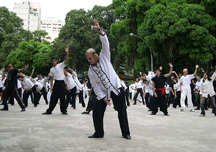
The local events are independently organized by local tai chi and qigong schools, groups, and associations. The format of events varies by locality, although most involve free classes and mass exhibitions. International organizing for the event is done at the World Tai Chi and Qigong Day office in Overland Park, Kansas.
The global event began in 1999. However the first event, that inspired the global event, was held in Kansas City, Missouri, in 1998 on the lawn of the Nelson Atkins Museum of Art in midtown Kansas City, where the Kansas City Tai Chi Club held a mass tai chi exhibition and teach-in involving nearly two-hundred people. [2] CNN Headline News covered the event, which generated interest beyond Kansas City to quickly grow into a national and international event in the following years. [3] World Tai Chi and Qigong Day has been officially proclaimed by governors of 25 US states, the senates of California, New York, and Puerto Rico, by Brazil's National Council of Deputies, and officials in several nations.
In 2013 Harvard Medical School launched a series of lectures regarding medical research on tai chi benefits. The Harvard lecture series homepage was titled "Celebrating World Tai Chi Day." The Harvard Medical School Guide to Tai Chi, released in 2012, cited World Tai Chi Day, writing, "A reflection of how successful the invasion of [tai chi] has been is World Tai Chi Day, organized by Bill Douglas. One of the purposes of this day is "to bring people across racial, economic, religious, and geo-political boundaries, to join together for the purpose of health and healing, providing an example to the world." Millions of people around the world—65 nations participated in 2011—gather one day each year to celebrate the health and healing benefits of tai chi and qigong." This global event was founded by Bill Douglas and Angela Wong Douglas, co-authors of The Complete Idiot's Guide to T'ai Chi and Qigong (Penguin Alpha Books, fourth edition, 2012). Their book's chapter entitled, "World T'ai Chi and Qigong Day," was a major force behind the global awareness of this health and healing event.
In 2013 the National Council of Deputies in Brazil joined 22 U.S. Governors, the Senates of California, New York, and Puerto Rico and other officials and bodies from around the world in recognizing World Tai Chi & Qigong Day. [4] Local and national media worldwide have covered World Tai Chi & Qigong Day events, including Agence France Presse TV; [5] Egyptian national television news; [6] and New York City's Central Park event was covered by NDT Television News. [7]
In 2019 Southampton City Council celebrated World Tai Chi & Qigong Day alongside UK Shaolin Temple, who jointly held a free public event in Southampton's Guildhall Square on Saturday 27 April 2019. The event highlighted the importance of mental health and wellbeing awareness with free tai chi and qigong taster sessions. Near to one hundred attendees sampled a number of simple exercise routines to incorporate into their daily routines. The message of the event also reached hundreds of thousands of people through social media and regional press coverage including the Southern Daily Echo Press and BBC Solent.
This global healing event, in turn, inspired what is now known as World Healing Day.

Neijia is the collective name for the internal Chinese martial arts. It relates to those martial arts occupied with spiritual, mental or qi-related aspects, as opposed to an "external" approach focused on physiological aspects. The distinction dates to the 17th century, but its modern application is due to publications by Sun Lutang, dating to the period of 1915 to 1928. Neijing is developed by using neigong or "internal changes", contrasted with waigong or "external exercises".
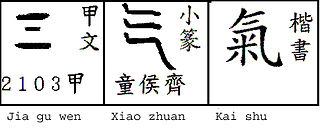
In traditional Chinese culture and the East Asian cultural sphere, qi or ch'i in Wade–Giles romanization or chi, is believed to be a vital force forming part of any living entity. Literally meaning "vapor", "air", or "breath", the word qi is a polysemous word often translated as "vital energy", "vital force", "material energy", or simply as "energy". Qi is a mythical concept in traditional Chinese medicine and in Chinese martial arts. The attempt to cultivate and balance qi is called qigong.

Tai chi is an internal Chinese martial art practiced for self-defense and health. Known for its slow, intentional movements, tai chi has practitioners worldwide and is particularly popular as a form of gentle exercise and moving meditation, with benefits to mental and physical health.

Cheng Man-ch'ing or Zheng Manqing was a Chinese expert of tai chi, Chinese medicine, and the so-called three perfections: calligraphy, painting and poetry. He was born in Yongjia, Zhejiang Province, during the Qing dynasty. Cheng died March 26, 1975; his grave is near the city of Taipei in Taiwan.

Mantak Chia is a Taoist Master. Mantak Chia is the creator of the Healing Tao, Tao Yoga, Universal Healing Tao System, and Tao Garden Health Spa & Resort, located in the northern countryside of Chiang Mai, Thailand. He wrote more than 60 books on Taoist practices and taught the principles of Taoist internal arts. His books have been translated into more than 40 languages. He views himself primarily as a teacher.
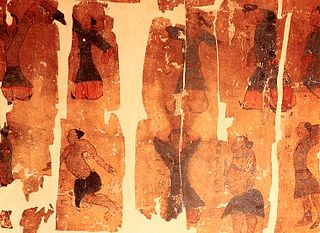
Daoyin is a series of cognitive body and mind unity exercises practiced as a form of Daoist neigong, meditation and mindfulness to cultivate jing (essence) and direct and refine qi, the internal energy of the body according to traditional Chinese medicine. These exercises are often divided into yin positions and yang positions. The practice of daoyin was a precursor of qigong, and was practised in Chinese Taoist monasteries for health and spiritual cultivation. Daoyin is also said to be a primary formative ingredient in the well-known "soft styles" of the Chinese martial arts, of tai chi, and middle road styles like Wuxingheqidao.

Dantian is a concept in traditional Chinese medicine loosely translated as "elixir field", "sea of qi", or simply "energy center". Dantian are the "qi focus flow centers", important focal points for meditative and exercise techniques such as qigong, martial arts such as tai chi, and in traditional Chinese medicine.
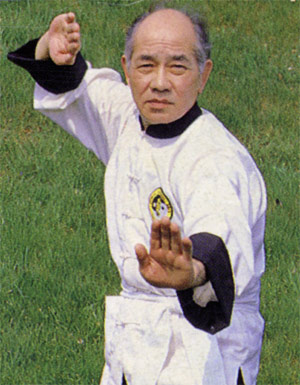
The Lee style of tai chi (李氏太極拳) is closely related to a range of disciplines of Taoist Arts taught within the Lee style including Qigong, Daoyin, Ch'ang Ming, Traditional Chinese Medicine, Taoist alchemy, Feng Shou kung fu, and weapons practice. According to practitioners, it was first brought to the West in the 1930s by Chan Kam Lee and was subsequently popularized by Chee Soo who was the President of the International Taoist Society from 1958 until his death in 1994. The Lee style of tai chi comprises two forms known as 'the dance' and 'the form'. Other exercises include Yifu Shou or 'sticky hands', Whirling Hands, Whirling Arms, and various qi and Li development exercises. Lee style t'ai chi is related to Martial Arts training, and there are five distinct areas of development that comprise the whole Art:
Neigong, also spelled nei kung, neigung, or nae gong, refers to a series of internal changes that a practitioner goes through when following the path to Dao, and these changes may be achieved through practices including qigong or tai chi. Neigong is also associated with xingyi quan.

The microcosmic orbit (小周天), also known as the Self Winding Wheel of the Law, is a Taoist qigong energy cultivation technique. It involves deep breathing exercises in conjunction with meditation and concentration techniques which aim to develop the flow of qi along certain pathways of energy in the human body which may be familiar to those who are studying traditional Chinese medicine, qigong, tai chi, Neidan and Chinese alchemy. The exercise can be performed usually at first in a sitting position, but it can also be practiced standing as in Zhan zhuang or with movements included as with tai chi.

The International Taoist Tai Chi Society is an umbrella organization for the governance of its member associations around the world, which are dedicated to the teaching of Taoist Tai Chi. As of 2007, the organization had 40,000 members, including 15,000 in Canada, and was present in 26 countries. Since 2010 the Society refers to Taoist Tai Chi as Taoist Tai Chi internal arts of health.

Bruce Kumar Frantzis is a Taoist educator who studied Taoism in China.

Guang Ping Yang tai chi is a tai chi style descended from Yang-style tai chi. It claims to combine all the positive aspects of Yang-style with qualities that added strength and versatility. It's stances are lower and wider than Yang-style, but not as pronounced as Chen-style. Guang Ping is also distinguished by as little as a 51%/49% weight difference between leading and trailing foot in certain moves. A stronger, more balanced foundation gives the student more power and greater flexibility. Guang Ping Yang tai chi also combines Xingyiquan and Baguazhang energies, which can be seen in Guang Ping's spiral force energy and projecting force energy theories. It has become known as the "lost" Yang-style tai chi form.
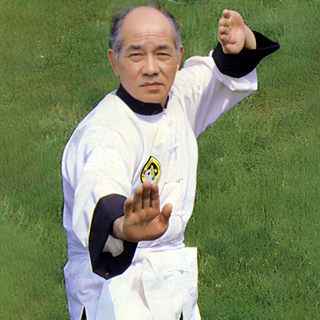
Chee Soo was an author of books about the philosophy of Taoism and in particular Lee-style tai chi, qigong, Ch'ang Ming, Traditional Chinese Medicine and Feng Shou 'Hand of the Wind' kung fu.
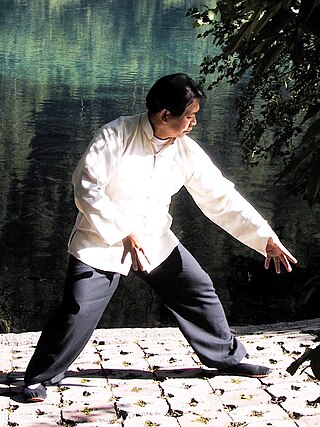
Qigong, is a system of coordinated body-posture and movement, breathing, and meditation said to be useful for the purposes of health, spirituality, and martial arts training. With roots in Chinese medicine, philosophy, and martial arts, qigong is traditionally viewed by the Chinese and throughout Asia as a practice to cultivate and balance the mythical life-force qi.
World Healing Day is a name used for a variety of events that have been held in hundreds of cities in over 65 nations. World Healing Day events have included yoga, prayer, tai chi, qigong, Reiki, faith healing, Meditation Day, Native Aboriginal Sacred Dance Day, Sufi Dance, Art and Music Healing.

Wudangquan is a class of Chinese martial arts. In contemporary China, Chinese martial arts styles are generally classified into two major groups: Wudang (Wutang), named after the Wudang Mountains; and Shaolin, named after the Shaolin Monastery. Whereas Shaolin includes many martial art styles, Wudangquan includes only a few arts that use the focused mind to control the body. This typically encompasses tai chi, xingyiquan and baguazhang, but must also include bajiquan and Wudang Sword. Although the name Wudang simply distinguishes the skills, theories and applications of the internal arts from those of the Shaolin styles, it misleadingly suggests these arts originated at the Wudang Mountains. The name Wudang comes from a popular Chinese legend that incorrectly purports the genesis of tai chi and Wudang Sword by an immortal, Taoist hermit named Zhang Sanfeng who lived in the monasteries of Wudang Mountain. Wudang quan is often used synonymously with Neijia, but Neijia is a broader term that also encompasses Aikido and Qigong, which are not Wudang quan.
Qigong, the Chinese practice of aligning breath, movement, and awareness for exercise, healing, and martial arts training, has a history that extends back more than 4,000 years. Contemporary qigong is a complex accretion of the ancient Chinese meditative practice xingqi or "circulating qi" and the gymnastic breathing exercise daoyin or "guiding and pulling", with roots in the I Ching and occult arts; philosophical traditions of Confucianism, Taoism, and Buddhism, traditional Chinese medicine and martial arts; along with influences of contemporary concepts of health, science, meditation, and exercise.

Xie Bingcan or Xie Bingshan was a notable expert and teacher of Qigong, Tuina, and tai chi.